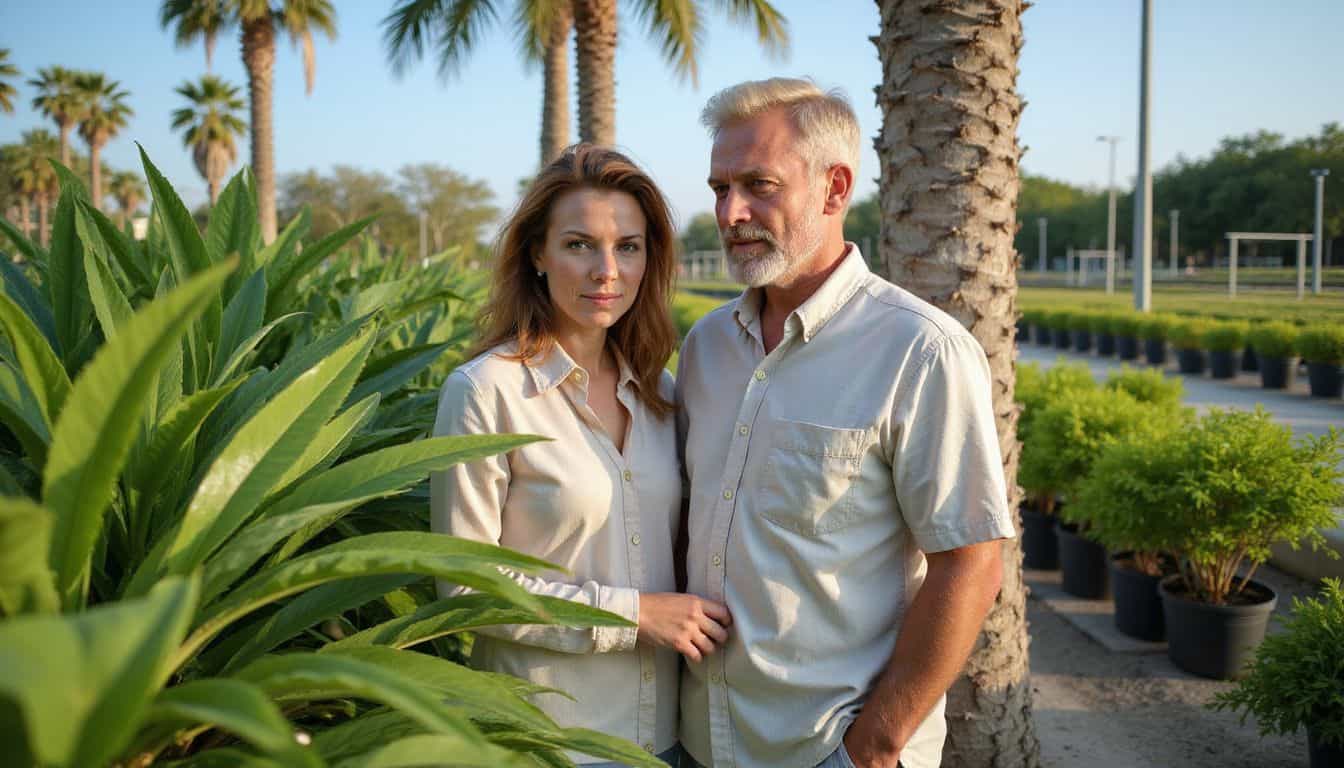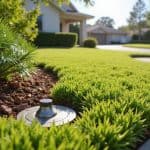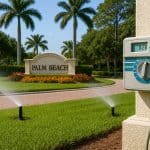
Royal Palm Beach homeowners face strict rules about their yards and gardens. Many residents struggle to keep up with HOA landscaping guidelines while trying to create beautiful outdoor spaces.
The wrong plant choices or unapproved changes can lead to fines and headaches for property owners.
Clear HOA landscaping rules protect home values and maintain community beauty in Royal Palm Beach. The rules cover everything from approved plant lists to lawn decorations. Smart landscaping choices focus on Florida-friendly plants that save water and thrive in local conditions.
Property managers must balance strict standards with practical maintenance needs.
Your yard can meet HOA rules while still looking great. This guide explores proven landscaping practices for Royal Palm Beach communities. You’ll learn about native plants, efficient irrigation, and maintenance strategies that work.
The right approach makes everyone happy.
Key Takeaways
- Royal Palm Beach HOAs require 60% Florida-native plants in new landscaping to save water and support local ecosystems.
- Florida-Friendly Landscaping™ principles from UF/IFAS Extension Service guide HOA practices through nine key standards that boost property values while protecting natural resources.
- Smart irrigation systems with rain sensors and moisture meters help properties save money on water bills, while native plants like Beach Sunflower and Firebush need minimal watering once established.
- Local companies like Coastal Gardens and Down To Earth offer sustainable landscaping services that follow HOA rules and use drought-resistant plants.
- Regular maintenance includes weekly mowing, monthly shrub trimming, and four yearly fertilizer treatments, plus organic mulching reduces pest problems by 30% according to 2020 research.
Sustainable Landscaping Practices
Sustainable landscaping creates a lasting impact on Royal Palm Beach properties through smart water management and native plant selection. Florida-friendly plants reduce water bills while protecting the local ecosystem from harmful chemicals and excess water waste.
Use Florida-Friendly Landscaping™ principles
Florida-Friendly Landscaping™ principles create smart and lasting solutions for commercial properties. The University of Florida/IFAS Extension Service supports nine key principles that boost property values while protecting natural resources.
These practices focus on putting the right plants in the right places. Smart water usage through efficient irrigation systems helps businesses save money on water bills. Property managers can reduce maintenance costs through proper plant selection and placement.
Landscape designs must follow HOA guidelines while meeting Florida-Friendly standards. The program teaches businesses how to recycle yard waste and control stormwater runoff effectively.
Proper pest management keeps landscapes healthy without harmful chemicals. Native plants thrive in local conditions and need less care over time. Many commercial properties see reduced upkeep needs after switching to Florida-Friendly methods.
Local companies like Coastal Gardens in Palm Beach show great results using these techniques in their installations.
Incorporate drought-resistant plants and efficient irrigation systems
Smart landscaping choices help HOAs save money on water bills and maintenance costs. Royal Palm Beach businesses can reduce their expenses through drought-resistant plants and modern irrigation systems.
- Beach Sunflower and Firebush plants need very little water once they grow strong in the landscape.
- Native plants make up 60% of new installations under HOA rules to support water savings goals.
- Drought-ready plants fight off pests and diseases better, cutting down on fertilizer use and care time.
- Smart controllers watch the weather and soil moisture to water plants at the right times.
- High-efficiency sprinkler heads spray water exactly where plants need it most.
- Drip irrigation systems deliver water straight to plant roots without waste.
- Rain sensors stop watering systems during rainy weather to prevent overwatering.
- Professional irrigation setup and care leads to lower water costs and healthier plants.
- Local nurseries stock Florida-native plants that thrive in Palm Beach County’s climate.
- Regular system checks catch leaks early and keep water flowing correctly.
- Mulch around plants holds moisture in the soil and reduces water needs.
- Strategic plant grouping puts water-hungry plants together for efficient irrigation.
- Soil moisture meters guide precise watering schedules based on actual plant needs.
- Modern sprinkler heads create larger water droplets that resist wind drift.
Community Aesthetic Guidelines
A well-planned HOA landscape creates a unified look through strict design standards and plant choices. The right guidelines boost property values and make neighborhoods more appealing to potential buyers.
Maintain consistent design standards and approved plant lists
HOA rules require at least 60% Florida-native plants in new installations. The approved plant palette focuses on drought-tolerant shrubs and pollinator-friendly flowers that match Florida’s climate.
These standards help create uniform landscapes while preventing the spread of invasive species throughout Royal Palm Beach communities.
Landscape design principles stress the right mix of texture, color, and form in commercial properties. Native vegetation must stay in place, while banned plants need quick removal.
The HOA enforces strict rules about palm trees with heavy seeds and tall hedges that block views. Clear plant guidelines save businesses money by avoiding costly mistakes or delays in getting landscape approvals.
Set clear rules for lawn decorations and hardscaping projects
Clear rules govern lawn decorations and hardscaping in Royal Palm Beach HOAs. Homeowners must get written approval for outdoor items like fountains, garden art, and personal vegetable plots.
The guidelines ban plastic décor and large gnomes to protect property values. Strict size and color standards apply to all lawn furniture and sculptures.
Hardscaping projects need detailed plans before work starts. The rules cover fence height, style, and placement requirements. Gardens must use native plants and stay clear of sidewalks.
All outdoor items need proper storage out of public view. These standards help maintain visual appeal while meeting Americans with Disabilities Act rules for accessibility.
Regular Maintenance Strategies
Regular lawn care builds lasting beauty and saves money for HOA communities in Royal Palm Beach. Smart maintenance plans include pest control, tree pruning, and weed removal through integrated pest management methods.
Schedule routine trimming, weeding, and fertilization
Proper lawn care needs strict maintenance schedules for business properties. Smart planning creates lasting curb appeal and meets HOA standards.
- Mow grass weekly during peak growing seasons, cutting only one-third of blade height to keep lawns healthy and neat.
- Pull weeds by hand or apply selective herbicides every two weeks to stop unwanted plant growth in garden beds.
- Trim shrubs and bushes monthly to maintain clean shapes and prevent overgrowth into walkways.
- Water deeply once per week for 60 minutes to encourage strong root systems in all planted areas.
- Schedule fertilizer treatments four times yearly with balanced products that match soil needs.
- Remove dead plants and debris twice monthly to prevent pest problems and maintain clean appearances.
- Check irrigation systems weekly for leaks or broken heads that waste water resources.
- Apply fresh mulch layers every spring and fall to control weeds and hold moisture in soil.
- Prune trees annually to remove dead branches and shape canopies for safety and aesthetics.
- Test soil pH levels twice yearly to adjust fertilizer types for optimal plant health.
- Create detailed maintenance logs to track all landscaping activities and results.
- Install rain sensors on sprinklers to prevent overwatering during wet weather.
- Use integrated pest management practices to control insects without harmful chemicals.
- Clear drainage systems monthly to prevent water pooling and plant root damage.
Implement pest management and mulching practices
Pest control and mulching form vital parts of HOA landscape maintenance. Smart pest management paired with effective mulching creates a strong defense against garden threats while saving money.
-
- Organic mulch layers attract good bugs that fight harmful pests, leading to 30% less crop damage based on 2020 research findings.
- Plant Health Care services track pest issues before they spread through regular site checks and early treatment plans.
- Native plants resist local pests better than imported species, cutting down the need for chemical sprays in your landscape.
- Wood mulch spread 2-3 inches deep stops most weeds from growing while keeping soil moist and healthy.
- Rotating different plants in garden spaces breaks pest life cycles and reduces repeat infestations.
- Integrated pest management combines natural controls with targeted treatments to protect plants while staying eco-friendly.
- Local weather patterns guide mulch choices, as some materials work better in wet or dry conditions.
- Regular mulch renewal keeps soil nutrients balanced and helps prevent both pest problems and plant diseases.
- Professional monitoring catches pest issues early through scheduled landscape inspections.
- Moisture control through proper mulching reduces plant stress, making them stronger against pest attacks.
- Chemical-free pest solutions paired with organic mulches create safer environments for beneficial insects.
- Strategic plant spacing with mulch barriers limits pest movement between garden areas.
HOA Landscaping Best Practices in Royal Palm Beach
Royal Palm Beach HOA landscaping rules focus on Florida-Friendly Landscaping™ methods. Smart irrigation systems help save water through precise watering schedules. Local experts like Coastal Gardens and Down To Earth provide sustainable services that match HOA needs.
These companies use drought-resistant plants such as palms, lantana, and native grasses to create water-wise landscapes.
Clear HOA guidelines make yard care simple for everyone. The rules cover lawn decorations, regular weeding, and fertilizing schedules for common areas. Proper stormwater management stops erosion and keeps water clean.
Many HOAs now push for yard waste recycling and wildlife-friendly spaces within set boundaries. Local regulations guide these practices to avoid neighbor disputes and create beautiful communities.
Conclusion
Successful HOA landscaping practices create beautiful, sustainable communities in Palm Beach County. Smart planning with native plants and proper maintenance keeps properties looking great while saving water.
Following these guidelines helps homeowners protect their investment and maintain high property values. The right mix of rules and eco-friendly methods makes neighborhoods more appealing and environmentally sound.
Clear communication between HOAs and residents ensures everyone works together for beautiful, lasting results.
FAQs
1. What are the best practices for water conservation in HOA landscaping?
Install efficient irrigation systems and sprinklers. Use rain barrels to collect water during wet seasons. Native plants help reduce water waste during drought conditions.
2. How can HOAs maintain healthy trees in Royal Palm Beach?
Regular tree trimming keeps ornamental trees strong and prevents damage from storms. A proper pruning schedule helps manage tree roots and protects nearby infrastructure.
3. What pest control methods work best for HOA landscapes?
Integrated pest management (IPM) helps control invasive insects and plant pests while creating a healthier environment for residents.
4. How should HOAs plan their landscape design?
Create detailed site plans that include native plants, rain gardens, and proper drainage systems. Consider both curb appeal and environmental sustainability in your garden design.
5. What lawn maintenance schedule works best in Palm Beach County?
Schedule regular mowing, weed control, and soil testing every season. Professional lawn care teams should follow a maintenance checklist to ensure consistent results.
6. How can HOAs make their landscapes more environmentally friendly?
Plant native species that attract birds and beneficial insects. Install birdbaths and create natural areas with berries and flowering plants. Focus on reducing pollutants through proper weed management.



